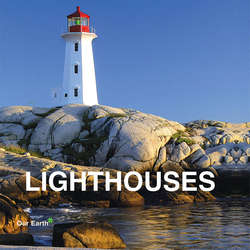Читать книгу Lighthouses - Victoria Charles - Страница 4
На сайте Литреса книга снята с продажи.
Africa
ОглавлениеRas Nungwi Light, 1926 (station established 1881).
Height: 14 m. Zanzibar. Focal plane: 18 m, one white flash every 5 seconds.
Port Shepstone Lighthouse, 1906 (imported from Great Britain).
Cast iron, height: 8 m. Port Shepstone, South Africa.
The lighthouse at Port Shepstone, named in honour of Sir Theophilus Shepstone, an admired South African statesman, was originally erected in 1895. At that time, it was a simple beacon made up of a lantern hoisted atop a laddered structure. This incarnation of the lighthouse was removed in 1905, and a cast iron tower topped with a radio beacon was built in its place in 1906. The current lighthouse has a white light that revolves and flashes once every six seconds. It is painted in unique black and white checkers, making it a whimsical addition to the landscape.
Ras Boujdour Lighthouse, 1903.
Masonry, height: 45 m. Cape Boujdour, Morocco.
Three white flashes every 15 seconds, range: 24 nautical miles.
Cape Spartel Lighthouse, 1864.
Masonry, height: 24 m. West of Tangier, Morocco.
Four white flashes every 20 seconds, range: 30 nautical miles.
Slangkop Lighthouse, 1919.
Cast iron, height: 41 m. Kommetjie, Western Cape, South Africa.
Slangkop lighthouse, whose name means “snakehead lighthouse”, is the tallest cast iron lighthouse in South Africa, towering forty-one metres above the landscape. It has been illuminating the Kommetjie coast since 1919; it was electrified in 1936 and automated in 1975. The light flashes four times every thirty seconds and can be seen up to thirty-three nautical miles away, keeping passing ships away from the rocky coastline.
The lighthouse’s interior is empty save a spiral staircase and a few landings, as well as a couple of diesel motors that provide power in case of an electrical failure. It has a balcony around the top of tower, allowing access to the windows for cleaning. It is also a remarkable lookout point, for those brave enough to make the climb.
Umhlanga Lighthouse, 1954.
Height: 21 m. Umhlanga, South Africa. Three flashes every 20 seconds.
The beach at Umhlanga, a town in South Africa, is marked by its lighthouse that towers twenty-one metres above the shore. Since its construction in 1954 replacing the decommissioned structure from 1869, the current lighthouse has become a landmark of the area.
The beam of the lighthouse has the strength of 600,000 candles and flashes every twenty seconds. It can be seen from up to twenty-four nautical miles away. Unlike most lighthouses, the Umhlanga lighthouse has never had a lighthouse keeper that lived on site. The lights are monitored and operated from the Oyster Box Hotel near the tower, which houses the controls.
Robben Island Lighthouse, 1864.
Height: 18 m. Robben Island, South Africa. One 5-second white flash every 7 seconds, range: 24 nautical miles.
Pelican Point Lighthouse, 1931.
Cast iron, height: 30.7 m. Walvis Bay, Namibia. Three white flashes every 20 seconds.
Cape Agulhas Lighthouse, 1849.
Stone, height: 27 m. Cape Agulhas, South Africa.
One white flash every 5 seconds, range: 30 nautical miles.
Cape Agulhas is the southernmost point of Africa and the location of the official meeting point of two powerful oceanic currents, the warm Agulhas current and the cold, dangerous Benguela current. The cape boasts a remarkable lighthouse. This landmark was the third lighthouse to be built on the coast of South Africa. It was built in 1849, and its design was inspired by the legendary Pharos of Alexandria. The structure underwent restoration in 1968 after it was declared unsafe. It is now a monument that houses a museum and remains an active beacon, flashing its white light every five seconds.
The cape’s name means “Needle Cape”, because at its location the compass needle points straight north. The name may also hint at the danger of the coastline with its sharp reefs and the rough seas and stormy weather of the area. The seafloor here is covered with remnants of shipwrecks such as the Arniston (1815), Elise (1877) and Gwendola (1968), to name a few.
Cape Recife Lighthouse, 1851.
Masonry, height: 24 m. Port Elizabeth, South Africa.
Flashing white light every 30 seconds.
Mouille Point Lighthouse, 1824.
Cape Town, South Africa.
Danger Point Lighthouse, 1895.
Height: 18.3 m. Gansbaai, South Africa.
Three flashes every 40 seconds.
Originally named the Ponte de São Brandão by Bartholomew Diaz in 1488, this point was dubbed Danger Point due to its treacherous reef and rocky coastline. It is also known for its large population of great white sharks in the seas off the coast.
Before the lighthouse was constructed, the HMS Birkenhead, a British ship carrying troops and their families, was wrecked on the reef, claiming 450 lives. Now the lighthouse is a powerful beacon, as well as a memorial site to this incident.
Donkin Lighthouse, 1862.
Height: 26.2 m. Port Elizabeth, South Africa.
This lighthouse at Port Elizabeth is part of the Donkin Reserve, a park overlooking Algoa Bay. Port Elizabeth was named after the wife of Sir Rufane Donkin, who was the acting governor of the Cape Colony in the early 1800s. The stone pyramid located next to the lighthouse is a memorial to her. This lighthouse is no longer active, having been decommissioned in 1973, but now it serves as a tourist centre and lookout point.
Stompneusbaai (Blunt Nose Bay) Lead Light, c. 1920s.
Brick, height: 8 m. Stompneusbaai, Shelley Point, South Africa.
Cape Columbine Lighthouse, 1936.
Cape Columbine, South Africa. One white flash every 15 seconds, range: 32 nautical miles.
Rabat Lighthouse, 1920.
Height: 24 m. Rabat, Morocco. Two white flashes every 6 seconds, range: 16 nautical miles.
